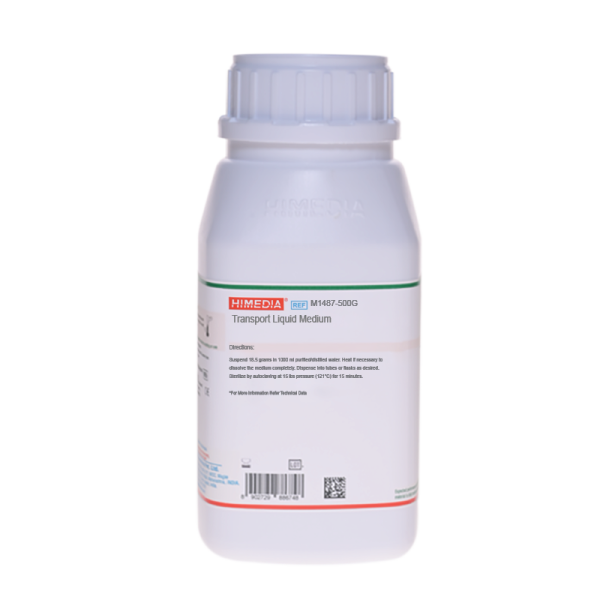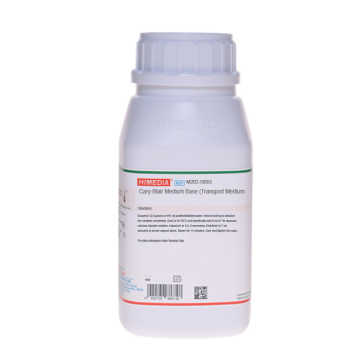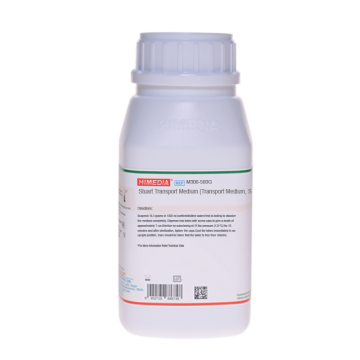 Your enquiry has been submitted
Your enquiry has been submitted
Transport Liquid Medium
Intended Use
For recovery of microorganisms by neutralizing the disinfectants and antiseptics.
Composition**
| Ingredients | g / L |
|---|---|
| Tryptone | 5.000 |
| Dextrose (Glucose) | 2.000 |
| Sodium thiosulphate | 5.000 |
| Sodium thioglycollate | 1.000 |
| Sodium bisulphite | 1.000 |
| Polysorbate 80 (Tween 80) | 1.000 |
| Dipotassium hydrogen phosphate | 1.000 |
| Yeast extract | 2.500 |
Final pH ( at 25°C) 7.6±0.2
**Formula adjusted, standardized to suit performance parameters
Directions
Suspend 18.5 grams in 1000 ml purified/distilled water. Heat if necessary to dissolve the medium completely. Dispense into tubes or flasks as desired. Sterilize by autoclaving at 15 lbs pressure (121°C) for 15 minutes.
Principle And Interpretation
The medium is slight modification of medium developed according to the procedure of Engley and Dey (1) and is recommended for recovery of microorganisms by neutralizing the disinfectants and antiseptics used while taking swab specimen from wounds, burns and other clinical specimens.
Tryptone provides nitrogenous compounds while yeast extract, B complex vitamins, dextrose provides the carbon source. The neutralizers in the medium inactivate a variety of disinfectant and antiseptic chemicals. Sodium bisulfite neutralizes aldehydes, sodium thioglycollate mercurials and sodium thiosulphate neutralizes iodine and chlorine, polysorbate 80 neutralizes substituted phenolics (2,3,4,5).
Type of specimen
Clinical samples - Swab specimen from wounds, burns and other clinical specimens.
Specimen Collection and Handling
For clinical samples follow appropriate techniques for handling specimens as per established guidelines (6,7). After use, contaminated materials must be sterilized by autoclaving before discarding.
Warning and Precautions
In Vitro diagnostic Use only. For professional use only. Read the label before opening the container. Wear protective gloves/protective clothing/eye protection/ face protection. Follow good microbiological lab practices while handling specimens and culture. Standard precautions as per established guidelines should be followed while handling clinical specimens. Safety guidelines may be referred in individual safety data sheets.
Limitations
- Due to nutritional variations, some strains may show poor growth.
Performance and Evaluation
Performance of the medium is expected when used as per the direction on the label within the expiry period when stored at recommended temperature.
Quality Control
Appearance Cream to yellow homogeneous free flowing powder
Colour and clarity of prepared medium Light yellow coloured clear solution
Reaction Reaction of 1.85% w/v aqueous solution at 25°C. pH : 7.6±0.2
pH 7.40-7.80
Cultural Response Cultural characteristics observed after an incubation at 35 - 37°C for 40-48 hours.
| Organism | Growth |
|---|---|
| Bacillus spizizenii ATCC 6633 (00003*) | good |
| Escherichia coli ATCC 25922 (00013*) | good |
| Pseudomonas aeruginosa ATCC 27853 (00025*) | good |
| Staphylococcus aureus subsp. aureus ATCC 25923 (00034*) | good |
Key : *Corresponding WDCM numbers.
Storage and Shelf Life
Store between 10-30°C in a tightly closed container and the prepared medium at 15-30°C. Use before expiry date on the label. On opening, product should be properly stored dry, after tightly capping the bottle in-order to prevent lump formation due to the hygroscopic nature of the product. Improper storage of the product may lead to lump formation. Store in dry ventilated area protected from extremes of temperature and sources of ignition Seal the container tightly after use. Product performance is best if used within stated expiry period.
Disposal
User must ensure safe disposal by autoclaving and/or incineration of used or unusable preparations of this product. Follow established laboratory procedures in disposing of infectious materials and material that comes into contact with clinical sample must be decontaminated and disposed of in accordance with current laboratory techniques (6,7).
Reference
- Engley and Dey 1970. Chem Spec Manuf. Assoc. Proc., Mid Year Meeting., p 100.
- Brummer. 1976 Appl Environment. Microbiol 32:80.
- Erlandson and Lawerence. 1953 Science 118 : 274.
- Quisno, Gibby and Foter., 1946 Am J. Pharm 118 : 320.
- Salfinger Y., and Tortorello M.L., 2015, Compendium of Methods for the Microbiological Examination of Foods, 5th Ed., American Public Health Association, Washington, D.C.
- Isenberg, H.D. Clinical Microbiology Procedures Handbook 2nd Edition.
- Jorgensen, J.H., Pfaller, M.A., Carroll, K.C., Funke, G., Landry, M.L., Richter, S.S and Warnock., D.W. (2015) Manual of Clinical Microbiology, 11th Edition. Vol. 1.
| Product Name | Transport Liquid Medium |
|---|---|
| SKU | M1487 |
| Product Type | Regular |
| Physical Form | Powder |
| Origin | Animal |
| Packaging type | HDPE |
| References | 1.Engley and Dey 1970. Chem Spec Manuf. Assoc. Proc., Mid Year Meeting., p 100.2.Downes and Ito (ed.) 2001. Compendium for methods for the microbiological examination of foods, 4th ed. American PublicHealth Association, Washington D.C.3.Quisno, Gibby and Foter., 1946 Am J. Pharm 118 : 320.4.Erlandson and Lawerence. 1953 Science 118 : 274.5.Brummer. 1976 Appl Environment. Microbiol 32:80. |
| Customized Product Available | No |









